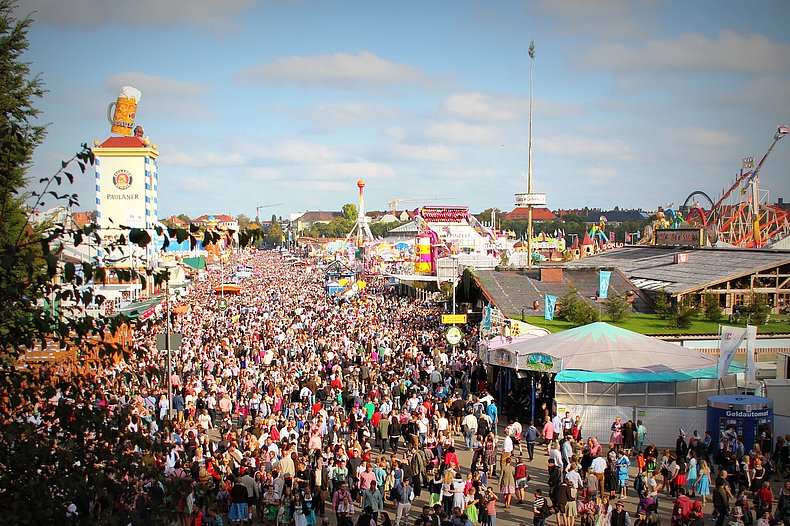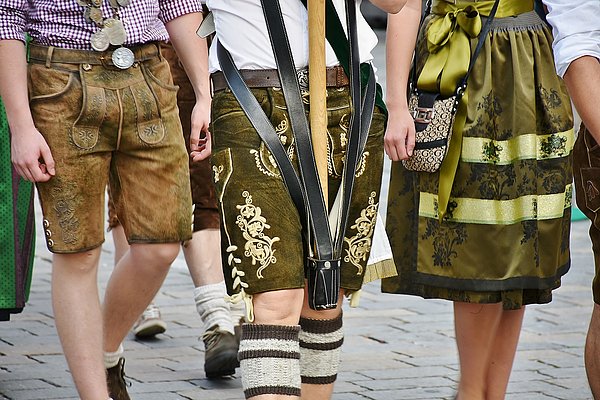Abroad, Germany’s image is shaped above all by one thing: the Oktoberfest in Munich. More precisely, men in leather trousers, women in dirndls, huge beer mugs and a plate full of sauerkraut and pretzels. In fact, the Oktoberfest is the most visited folk festival in Germany and exists since more than 200 years. For you we have briefly summarized what it has to offer, how the festival came into being, how to dress in proper style and what tips you should pay attention to, if you want to visit the Theresienwiese in Munich.
O‘ zapft is! – Oktoberfest in Munich
What is Germany's most famous folk festival all about?
What, when and where?
Yes, it's called Oktoberfest, but Germany's largest folk festival starts regularly in mid-September, 2019 on Saturday, 21st. The festivities then last about two weeks, this year until 6th October. The name of the festival goes back to the times when it actually took place in mid-October. That was changed however, simply because the Munich weather in September is usually better and one did not want to risk to let the celebration fall through. Unlike the time, the venue has remained the Theresienwiese in Munich, the capital of Bavaria ever since. On this 42 hectare open space, numerous fairground stalls, food and drink stands as well as rides like giant wheels are set up. The highlights of the festival are the numerous tents surrounded by beer gardens. Here, Bavarian specialties and so-called Mass of Oktoberfest-beer are served, music is played and people celebrate. You can find out exactly how to get into the tents and what the specially brewed beer is all about in the further below.
Origin and History of the Oktoberfest
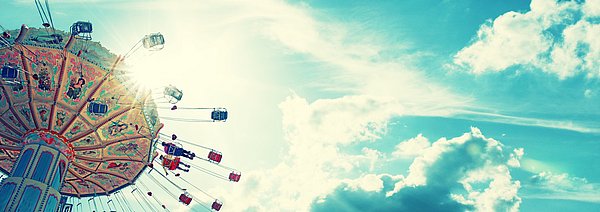
In fact, today's Oktoberfest has little to do with its origin. The first time it celebrated the wedding of Prince Ludwig of Bavaria and Princess Therese Sachsen-Hildburghausen in 1810 on October 17. She was the one to give the Theresienwiese its name. All inhabitants of Munich were invited to this event and are said to have celebrated peacefully and joyfully - without alcohol, which was not permitted to be served on the fairground. Instead, there were small stalls, marquees and merry-go-rounds, which appealed above all to families with children. The ceremony ended with a horse race. Due to its great success, the event was repeated the following year and the following and so on. Thus, the annual folk festival became more and more popular and, with the exception of the World War years, has been held every year ever since. The Wiesn, as the people of Munich call it, has been joined by the oide, the old Wiesn in 2010. Here, you will find two family-friendly festival tents, nostalgic carousels and horse races, which shell remind of the origin of the festivities and is particularly linked to Bavarian Tradition.
O' zapft is! - The Opening Ceremony
When the talk is of the Oktoberfest, one reads and hears again and again this one sentence: "O' zapft is!" That means as much as "It is tapped". Since 1950 there is a fixed opening ceremony of the Oktoberfest. Always on the first Saturday of the festivities at exactly 12 o'clock the acting mayor of Munich pierces the first beer barrel in the Schottenhamel festival tent and then calls "O' zapft is! To a peaceful Wiesn!" The first Mass beer is reserved to the Bavarian Prime Minister since 1980. Only after he has received his festive beer the remaining visitors may be supplied with it. By the way, the first keg of beer can take different lengths of time to be kicked off: Christian Ude and Dieter Reiter succeeded in the quickest stitches with only two strokes. Ude, however, also holds the negative record with 20 strokes.
How's it going with the tents?
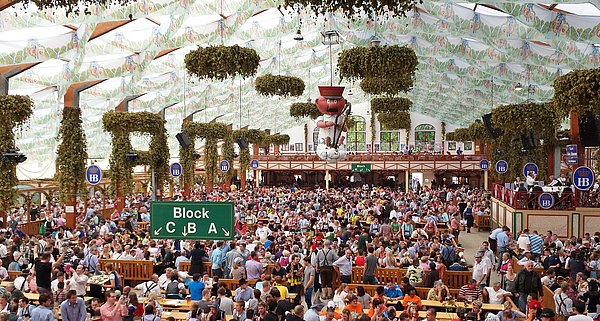
As already mentioned, the festival tents at the Oktoberfest are particularly popular. Here, Bavarian specialties such as veal sausage, sauerkraut, pretzels and knuckle of pork are served as well as the Mass of Oktoberfest beer. A Mass is a special unit, a beer mug that holds one liter – about half a six-pack. The beer is brewed especially for the Oktoberfest and not a normal wheat beer as usual in Bavaria otherwise. It rather reminds of a lager beer but has a higher alcohol content of around 6%. Brewing the official beer is reserved for the six Munich breweries. These breweries also run some of the 16 festival tents on the grounds, where Bavarian brass and party music is played. The number of seats in the tents varies between 2,500 and 10,900. However, getting one of these is not as easy as you might think. Especially on the weekends it is not uncommon that tents are closed due to overcrowding and can only be entered with a reservation. As a rule, a seat can be reserved as early as April – which is why many of the coveted places are occupied well in advance. Even if you have a reservation, be careful: If you are not on time, it will expire quickly. On the other hand, this is exactly what you can make use of, if you don't have one: At shift changes, often around 16:00 to 16:30 in the evening, you have the best chance to get a table. If you as a student can arrange to come to the Oktoberfest during the week, the situation is much more relaxed anyway. If none of this works, you still have the option of finding a seat in the beer gardens around the tents. There are usually no reservations accepted and the atmosphere is almost as beautiful and cultural as in the tent. Keep in mind, that food and drinks in the marquees is not exactly a bargain: in 2019, the price of one Mass is supposed to be around 11 to 12 €. By the way, there is also a special wine tent for those of you who are not beer drinkers, and of course, various non-alcoholic drinks are offered as well.
How do you dress properly?
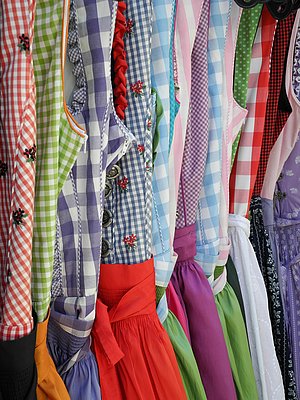
There is no fixed dress code for the Oktoberfest. If you like, you can also wear jeans and a t-shirt on the festival grounds. However, you should be aware that you will probably attract more attention, especially if you want to go to the festival tents. For most people, wearing traditional costumes is simply part of the Wiesn. Still, most wear a current version, a kind of traditional costume fashion as the original costumes are varying a lot from region to region and subject to strict rules. Today, most men wear leather trousers. They are available in all lengths, but the knee-length ones are particularly popular. These are also often connected with braces or a bib and decorated with traditional embroidery. Their outfit often also includes a (mostly checked) linen or cotton shirt, knitted stockings and a pair of sturdy shoes. You will also often see hunter's hats, leather vests or traditional jackets. Meanwhile more and more women wear leather trousers with corresponding shirts or bodices as well, but the Dirndl is still most popular among women. These dresses always consist of at least a dress and an apron, sometimes a separate bodice and a dirndl blouse are part of them as well. The upper part of a Dirndl is usually tight fitting, often laced or buttoned and showing a large neckline. The skirt, on the other hand, has a loose, falling cut. Very important for the Dirndl is the correct positioning of the apron bow as this says a lot about your relationship status! A bow in the middle of the belly is intended for virgins or women whose relationship status is not completely clear. Singles wear the bow (seen from themselves) on the left, who is taken, on the right. A bow on the back is intended for widows and waitresses. In addition, women especially like to wear more or less elaborate braided hairstyles. But don't panic: You don't have to buy expensive costumes and go to the hairdresser to take part in the Oktoberfest in proper style. Especially for young adults, there are inexpensive and simple variations of the popular traditional costumes in all common fashion shops by the time the Wiesn takes place - which most, including German students fall back on.
Tips & Recommendations
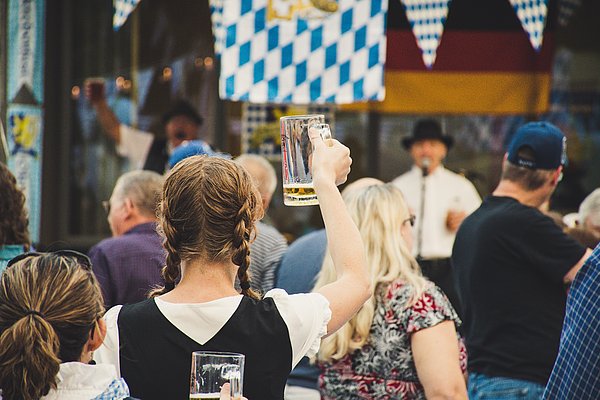
Visiting the Oktoberfest is certainly a special experience and allows an extraordinary insight into Bavarian culture. It is, however, also a huge event where many people consume a lot of alcohol. Especially the high percentage of the festival beer as well as the size of the Mass leads again and again to the fact that visitors misjudge themselves and drink so much that they no longer act responsible or have to vomit. So take good care of each other and don't get involved in discussions or quarrels with scrappy drunks. Nevertheless, most Oktoberfest visitors are in a good mood and contact-friendly, which can also give you the opportunity to talk to interesting people you might never have met otherwise. If you want to go to Munich for the Wiesn, you should also arrange your accommodation as well as your arrival and departure as far in advance as possible. As the Wiesn draws closer, all offers are in great demand and become more and more expensive. In addition, it's best to stock up with enough cash before you enter the Theresienwiese - in most marquees you can't pay by card and in front of the few cash dispensers on the festival grounds there are often incredibly long queues. If you want to get to the fairground quickly, it's also a good idea to aim for a side entrance to avoid the big rush to the main one, which is caused by the relatively strict entrance controls. Also, be careful not to carry bags or backpacks larger than an A4 sheet of paper as they are forbidden. You should also wear comfortable shoes. Such a Wiesn day can become long and end up well and gladly times on one of the numerous after-Wiesn-parties. With aching feet all it’s half the fun. For those of you who are curious about the Oktoberfest, but for whom it all sounds like too much hustle and bustle, a visit of the oide Wiesn is recommended as the atmosphere there is much quieter and more traditional.
Well, we don't have much more to say than to wish you a lot of fun exploring Germany's biggest and most famous folk festival! If you are curious but can't make it to Munich in time, we would also like to reassure you: nowadays there are smaller offshoots of the festival all over Germany, although they honestly have more or less to do with the Bavarian original. Still, a little research should be enough to find an interesting offshoot in your area that will allow you to experience a little Wiesn feeling even with a small purse or full calendar.



